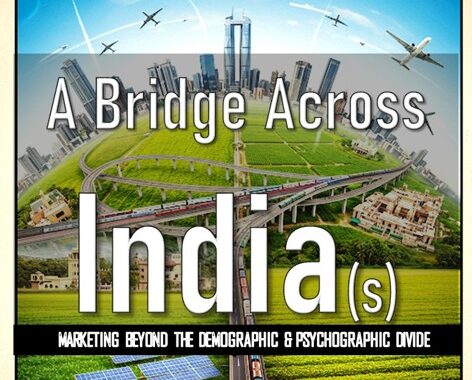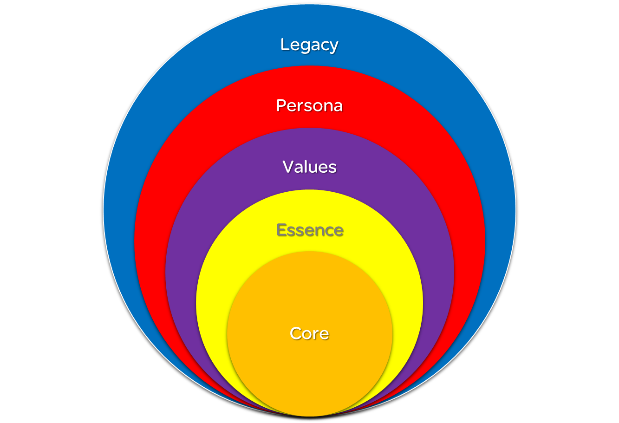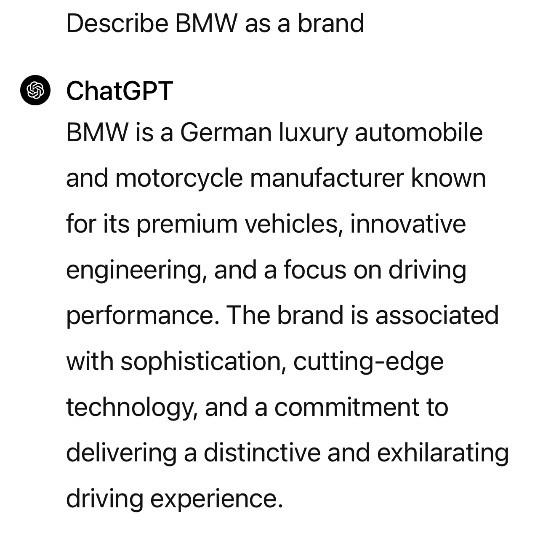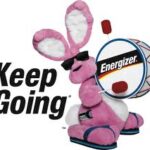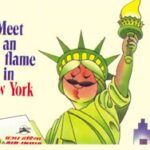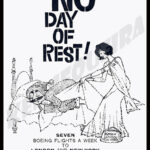Brand Supernovas (2025)

How many times have brands or companies simply be-dazzled you with their products, communication, pace of innovation, service delivery etc. and then suddenly dropped off the planet?
Not often, but I bet most of us would come up with an example or two.
Got thinking on similar lines and tried racking my brains to come up with a list my own. Funny thing with lists though is that you want the number of items on it to reach a nice round figure. What I figured was; whatever number that you can get to without stretching the core thought is probably the right number to have on the list. I am sure you nodded your head to that one.
Before I started writing this post I looked up the term “Supernova” in the dictionary
su·per·no·va (so͞o′pər-nō′və)
A rare celestial phenomenon involving the explosion of a star and resulting in an extremely bright, short-lived object that emits vast amounts of energy. Depending on the type of supernova, the explosion may completely destroy the star, or the stellar core may survive to become a neutron star.
I have for the purpose of this post highlighted what I believe are the operative parts.
Before I go on to cite examples let me establish the basic premise which is, a successful brand is the coming together of a great product or service and communication that resonates with the consumer leading to a distinctive identity, a marked preference and a position of leadership. Now, that’s an elevator pitch definition of brand success that covers most if not all bases.
Now brands fade for a variety of reasons and hundreds go into oblivion every day. Mostly because they didn’t deliver on the promise that they made. Reasons could be they stopped being relevant or they got complacent or they were poorly managed etc. The very opposite at one time or the other must have got them to the top. It is however important to make a distinction between brand supernovas and brand fads.
Brand supernovas are the ones that seemed to have got it right. Well at least for a while.
Now for the examples. Here are brands that shot up high and lit up the horizon while they were at it. Almost all these brands had a great product/service idea that went down extremely well with consumers, customers and investors. Not all of them spent big bucks on advertising and communication but they sure captured more than a fair share of imagination – to the extent that nobody imagined them going bust or fading away into oblivion.
- Fitbit – a pioneer in the wearables/fitness tracking space that rose to a dominant 37% market share and over USD10BN in market cap after going public in 2015. The heady success though didn’t last as Fitbit failed to sustain it’s first mover advantage. Wearables as a category saw a significant shift with brands like Apple upping their game. Fitbit’s revenue started to decline after 2016, and their market share also decreased considerably. Despite an initial high valuation, their brand value also saw a downward trend, eventually leading to their acquisition by Google in 2021. Google too sunset the brand soon after.
- PepperTap – Launched in 2014, India’s early attempt at quick commerce premised on a hyper-local /aggregation/commission based delivery model chalked up millions of subscribers and users as also millions of dollars in initial funding. To its credit, PepperTap had a fantastically simple and seamless user experience and some good algorithms to get the logistics right. However, a combination (arguably) of a misplaced sense of urgency wrt to expansion and heavy discounting saw the brand/company falter and lose its way. The fame and the glory were short-lived. By April 2016 PepperTap management had to announce a shut-down of it’s consumer facing operations. Subsequent attempts at revival in a B2B avatar too failed.
- Koo – Touted as India’s multi-lingual answer to X (erstwhile Twitter) this was a brand that lived only long enough to disappoint. The reason I mention Koo is that it reached a whopping 60MN users at it’s peak – no small achievement. Birthed at a time when India’s Nationalist sentiment was at it’s peak and perhaps helped along by an over-enthusiastic media response Koo did have something novel to offer to its users initially.
There of course are several other brands in the past decade that began their journey and met with great success. Some continue to grow, expand and flourish whilst some have run into some rough weather.
Some of the brands that spring to mind are Snapdeal, Groupon, Yumist which burnt bright for a brief while. Yet others such as Byju’s and WeWork on which the jury is still out.
Brand New Resolutions MMXXIV
I know, I know. Resolutions are passé. Nonetheless, I had to vent these thoughts that had been bubbling in my mind for the past few days and what better a way than to write a blog post. Since it was that time of the year I just decided to go ahead and put them in the form of an ancient ABVS tradition.
Without much further ado, let us jump right into my proposed Resolutions for Brands in 2024.
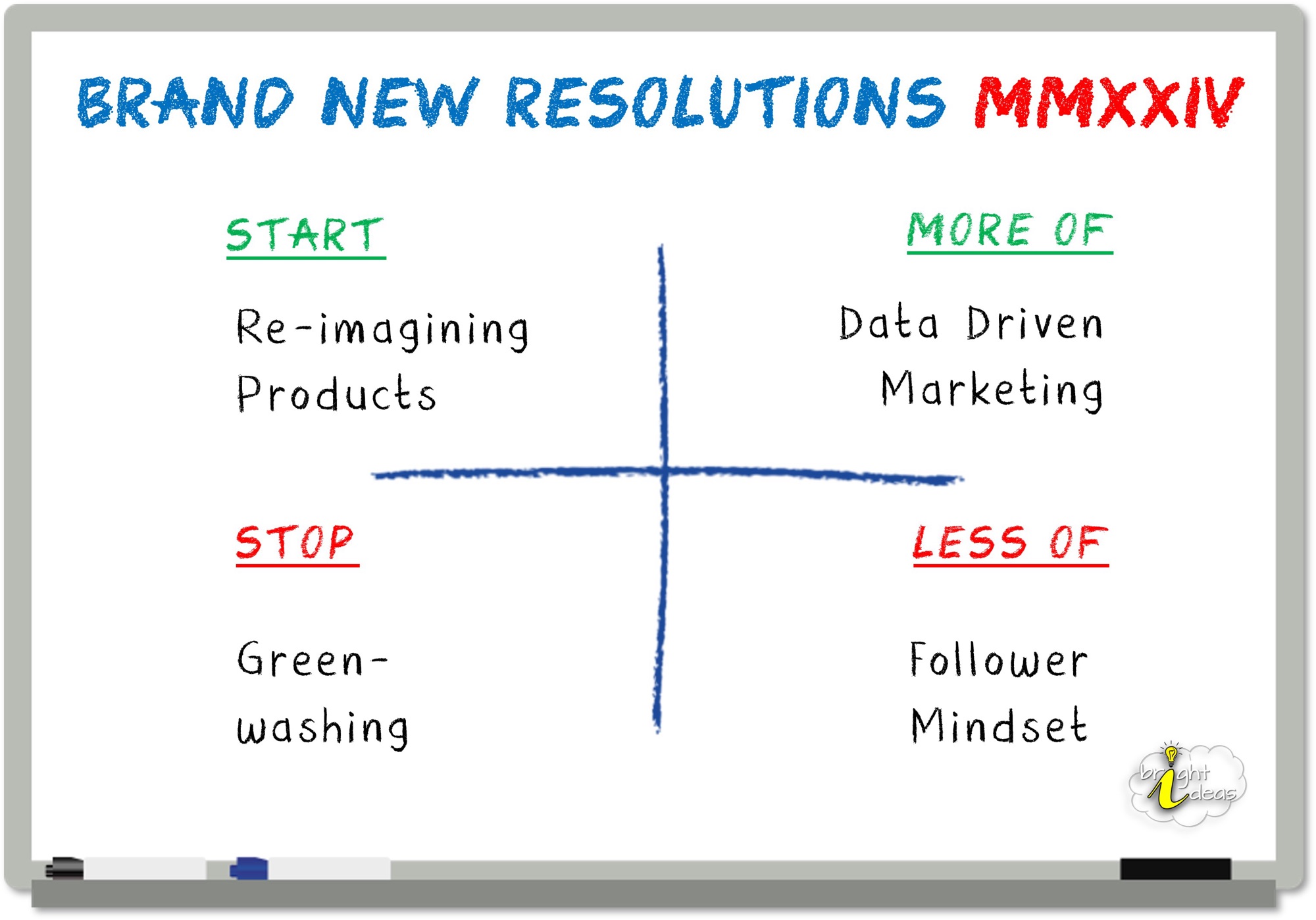
START | Re-imagining Products (&Solutions)
Enough and more has been written, discussed, and debated about how consumer and customer behaviour has seen a paradigm shift post-pandemic. That said, how many brands have re-thought or re-designed or re-organized their offering on account of this change? Not many one would reckon.
All of us acknowledge that it is a more connected world than it was pre-COVID19. Not because the technology was not available but because the adoption of technology had not happened. The pause in commerce in the 2 years of lockdowns has accelerated adoption journeys and tech roadmaps.

Therefore, in an IoT led world with AI making headlines and some real headway, dumb products without connectivity and with little or no user interaction are setting themselves up for failure if not extinction. Brands and more specifically Product Managers need to look hard at the JOB TO BE DONE and introduce some level of intelligence and interactivity in their offerings. The trap to avoid though is it being a lip-service or a gimmick.
STOP | Green-washing
Consumers today are more discerning. Only the brands GENUINELY integrating SUSTAINABLE in their narrative shall be able to or shall we say allowed to reap the rewards. Overtly simple methods of the last century such as using adjectives such as “Natural”, “Organic”, “Traditional” in communication will not work. It’s not just the offering but also the value proposition that needs to be sustained (sustainable).
Yes, there is a consumer who is willing to pay a premium for sustainably produced/sourced/managed products and solutions but that does not mean brands have a birthright to a higher price-point.
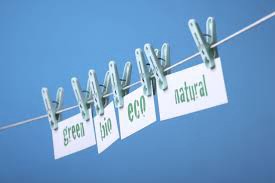
All brands sooner or later will need to spell out their vision and sustainability goals. Whether from a compliance perspective or from a consumer preference perspective or a market valuation perspective, brands shall be compelled to share their sustainability dashboards.
MORE OF | Data-driven Marketing
The downside of the social era has been that brands have started to confuse conversations with/ feedback from consumers with primary research, analysis, and culling insight. All marketers do understand that the Voice of Consumer is the starting point not the point itself. It is imperative that brands plan for and ensure that a strong understanding of the consumer/user continues to be the basis for creating products or solving problems.

Any understanding of the market that is built on data, reports and research is paramount and should take precedence over anecdotal evidence.
Research aside, consumer immersion is hygiene and brands should mandate this for their team. Every minute spent observing consumers in their setting is invaluable.
Many of my past colleagues at Nokia have (at that point in time very grudgingly) spent tens if not hundreds of hours in consumer visits. The repository of consumer understanding that the exercises built is something that I am sure all of us bank on till date – it is become the part that has honed our marketing intuition.
LESS OF | Follower Mindset
This is a pet-peeve. Also a sign of a lazy marketing organization. If something has worked for Brand A it is not necessary for Brand B to respond with a “Me Too”. Caution here is not to confuse this with being a fast-follower which isa well-accepted strategic approach.
A follower mindset is by definition reactive. Marketing teams that craft quick communication or value propositions based on market feedback beware. The battle for counter-share and shelf-share shall always force sales teams to demand an equivalent for a competitor’s new launch or variant. It is incumbent on the Marketers in the organisation to alter value for the consumers.
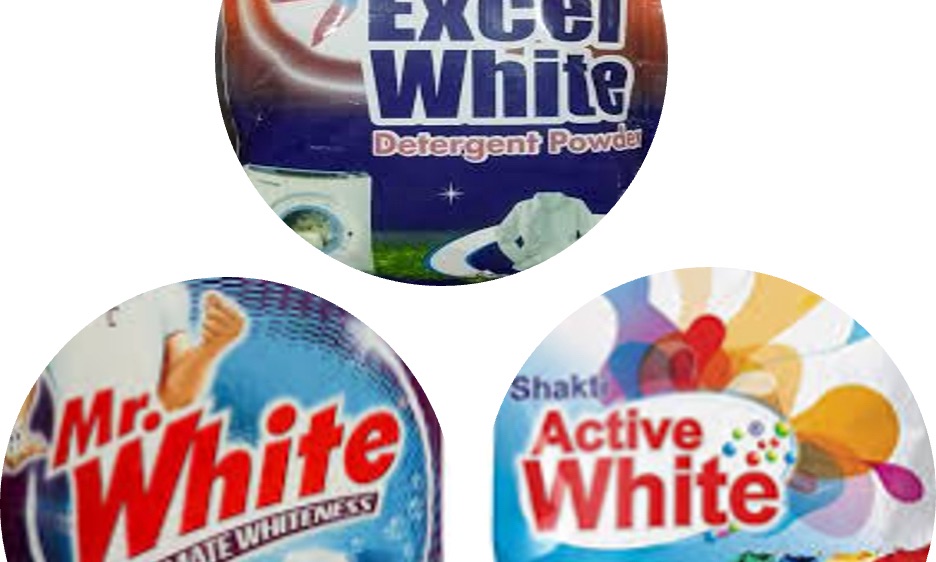
So be it a extra-lathering shaving cream or extra-whitening soap with dirt busters, the response cannot and should not be bigger, better, faster, more alone.
Points mentioned in the START and MORE OF if adopted should help brands come up with better ideas.
Here’s wishing all fellow marketers a great 2024!
Building Brands Intelligently in an Era of Artificial Intelligence
What is a brand? What does it take to build one? Who builds the brand – the marketing team, the product or service by virtue of its delivery of promise? Assuming one can be built is it possible for it to transform?
Questions that would make the best of marketers and gurus pause to reflect and collect their thoughts before they ventured an opinion.
Yes, you read that right! An opinion!! Likely a studied or considered one but opinion, nonetheless. Now, the author doesn’t claim to be an expert marketer either but sure is a passionate one. The very same passion that has brought the author to publish a post on ABVS after a long, very long time!
Most brands have a multi-layered existence that operates in a 3-dimensional space with the so-called 4th dimension being time. These layers tend to thicken over a period of existence during which every brand evolves, becoming more certain, contextual, and relevant.
Let’s understand the layers first.
- The innermost part (but naturally) is the Core of the brand. The core, as the word is defined in the dictionary, is the part that is central to the existence of the brand. The core of a brand is not unlike the calling that we humans oft struggle to find.
The questions that need answers are what am I about? What do I stand for?
The brand like all of us may well spend its lifetime trying to answer these questions. Also, much like us humans the brand also contends or grapples with these questions after having been in existence for a while. Very rarely, almost never is a brand born ready with answers to these questions. Greater understanding of this shall emerge when we look at the 3 dimensions of a brand’s existence.
- The next layer is the brand’s Essence. This is the layer that defines the playground for the brand or articulates the stage that the brand performs on.
The core and the essence of the brand often are to be articulated for and understood more by those who build it. The outcomes of doing so manifest in the layers that surround.
- The third layer is the one where the brand starts becoming more lifelike as its starts defining its own principles and standards of behaviour. Values give a window to and answer what drives or motivates a brand.
- Persona is the fourth layer of the brand. This is the layer that starts giving the brand a voice; answering the questions what do I say and how do I say it?
- Legacy is the outermost layer, the one that is all about the impact. What stays behind after you figured out your calling, performed on the stage, demonstrated what drives you and said what you wanted to the way you wanted say it.
Individually all the above are just words but collectively, they make an entity. One that is felt, seen, has a personality, stands for something and yes, gets talked about – a BRAND!
Before we move on to the dimensions of a brand’s existence it would be prudent to understand what we talked about with the help of an example.
The author mulled many different ones before settling upon BMW.
In sync with the times yours truly resorted to ChatGPT to “Describe BMW as a brand” (refer screenshot).
The answer that ChatGPT put forth is what this author shall use to build his theory of brand construct.
Sidenote: At this point, it makes sense to reiterate that the purpose of this article/post is to evoke/stimulate thought hence agreements and disagreements, mild or vehement are welcome. Please do leave your thoughts in the comments.
The CORE of brand BMW is “engineering”. When you start with an aircraft engine and then move to motorcycles and automobiles innovation is a given and therefore the ESSENCE of the brand. The VALUES of brand BMW are described by their “focus on driving performance”. BMWs ready association with “sophistication and cutting-edge technology” are indicative of its PERSONA. Finally, the brands “commitment to delivering a distinctive and exhilarating driving experience” is bound to be its LEGACY.
Overtly simple in retrospect? Not really, it has taken over a 100yrs of the brand being in existence for it to have the ability to be summarized so succinctly.
Which brings us to the dimensions of that hopefully, courtesy all that we have talked about explain themselves on their own.
Nonetheless, the 3-dimensional space that all brands operate in are as follows:
- Feeling
- Thinking and
- Social
Time speaks for itself as the 4th dimension.
Now the FEELING dimension is all about how a brand makes one feel. It is the tangible, experiential aspect of the brand. Continuing the BMW example. “Sheer driving pleasure”
The THINKING dimension delves into the evocative and subliminal aspects of the brand viz “innovative” and finally the SOCIAL dimension is projective and provocative – “sophistication/luxury/premium”.
All of which need TIME to build, consolidate and get entrenched into the psyche of the audience.
Summing up, a brand is so much more than a name that we choose.
A brand is the sum total of the experience that it delivers, the problems it helps solve, the job it gets done, the way it makes “me” feel, the way “you” see me, and the way the “world” shall remember the brand, you and me for having created and consumed it.
All of that, through its 5 layers and 3-dimensions!
Brand New Resolutions MMXVI
Hello!
Thank you all those who kept your faith in A Brand View Story…I am conscious that this blog lost its steam post April this year! Guess this is what happens if you back RaGa as a brand. Well…the real reason was that I got busy with the launch of my debut novel Eighteen The End Of Innocence. Incidentally though I started the morning with a troll on RaGa..so I am gonna give him a break and come back to Brand New Resolutions for 2016. We are gonna stick to my by now familiar format so here goes…
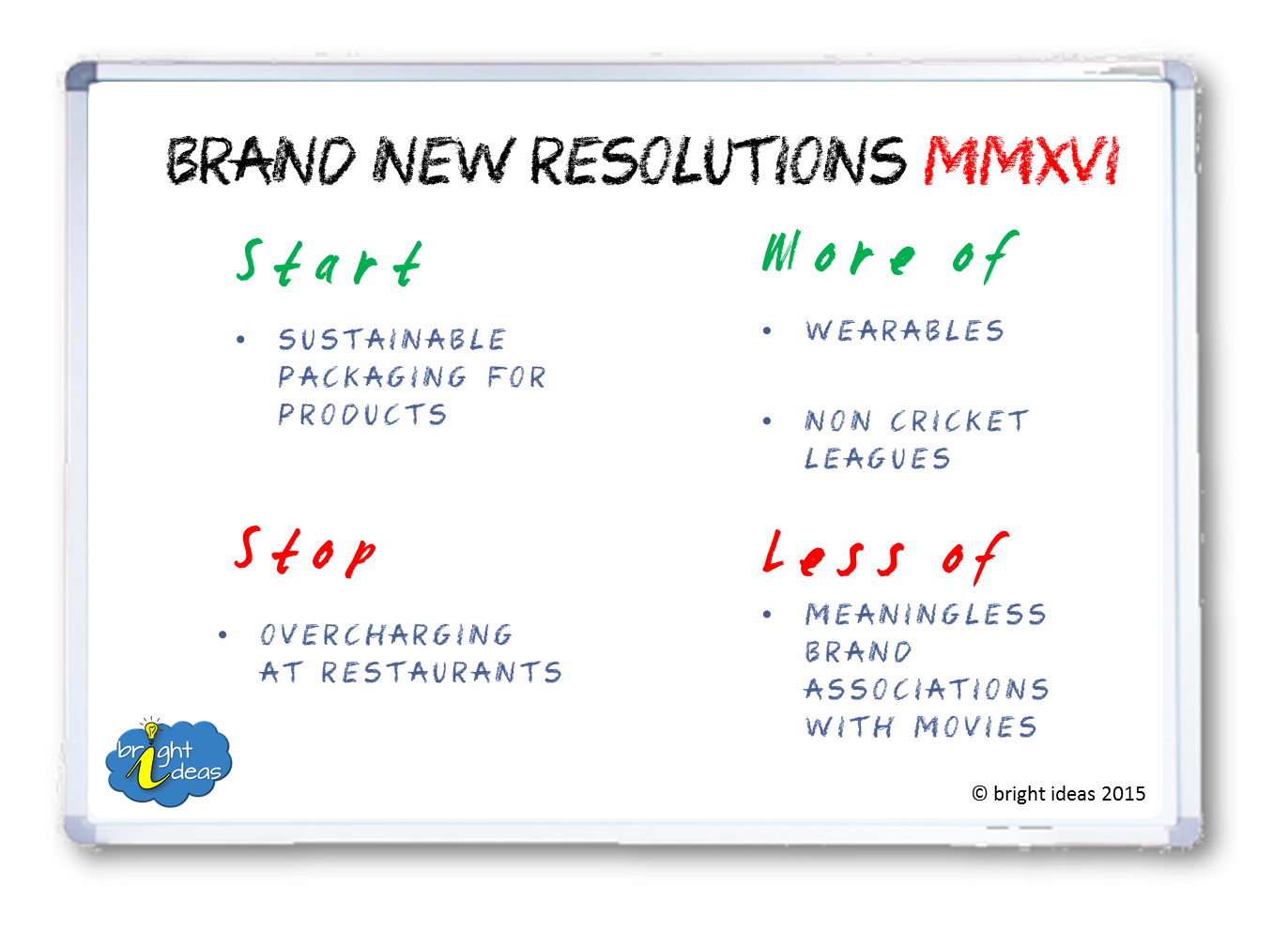
START Sustainable Packaging. Made a train journey recently and trust me the sight along the railway tracks was not a pleasant one. Tonnes of branded litter just lying around. From PET bottles to bags of wafers there they were strewn across boldly displaying their brands. If plastic is bad for the environment and use of paper leads to cutting of trees isn’t it about time we had more environmentally sustainable options? I would pay a rupee more if I had to. Hoping we all would.
Sustainable Packaging. Made a train journey recently and trust me the sight along the railway tracks was not a pleasant one. Tonnes of branded litter just lying around. From PET bottles to bags of wafers there they were strewn across boldly displaying their brands. If plastic is bad for the environment and use of paper leads to cutting of trees isn’t it about time we had more environmentally sustainable options? I would pay a rupee more if I had to. Hoping we all would.STOP

Overcharging! This one is a plea more as a consumer. A lot many restaurants organized and stand alone alike take their customers for a ride when they present the bill. This overcharging is mainly done under the garb of taxation. Larger populace is ignorant or unaware with regard to the taxes that are applicable when they are dining out and succumb to this con. It is not appropriate to take names or paint the industry with a broad brush but it is reality that a sizable number indulge in this malpractice. It would bode well for chains if they ensured their billing practices are in accordance with the law. Fortunately for them India is not a land where class action suits are filed else quite a few brands could potentially be caught on the wrong side of law.
 MORE OF
MORE OFWearables! We have seen a flurry of watches in 2015 on Android and iOS platforms and they certainly have piqued curiosity in many of us. Would like to see this go beyond watches during 2016 and within the watches space itself; more utility apps would be nice to see.
 Non-cricket leagues! It was heartening to see brands support sport other than cricket. The Football league, Kabbadi league, Tennis league all survived another season. The fact that TV ratings saw an increase for Kabbadi and also for the Football league (except on days when there was cricket featuring India) augurs well for both the future of the sport and the potential that exists for brands.
Non-cricket leagues! It was heartening to see brands support sport other than cricket. The Football league, Kabbadi league, Tennis league all survived another season. The fact that TV ratings saw an increase for Kabbadi and also for the Football league (except on days when there was cricket featuring India) augurs well for both the future of the sport and the potential that exists for brands. LESS OF
LESS OFMeaningless Brand Associations with Bollywood movies. Believe that brands tend to risk their credibility when they associate with motion pictures. These associations more often than not are led by stars rather than any synergies between the content/story-line of the film itself. Brands would do better than to just chase good money behind their brand ambassadors bad professional choices.
Brand Supernovas
 How many times have brands or companies simply be-dazzled you with their products, communication, pace of innovation, service delivery etc and then suddenly dropped off the planet?
How many times have brands or companies simply be-dazzled you with their products, communication, pace of innovation, service delivery etc and then suddenly dropped off the planet?Not often, but I bet most of us would come up with an example or two.
Got thinking on similar lines and tried racking my brains to come up with a list my own. Funny thing with lists though is that you want the number of items on it to reach a nice round figure. What I figured was; whatever number that you can get to without stretching the core thought is probably the right number to have on the list. I am sure you nodded your head to that one.
Before I started writing this post I looked up the term “Supernova” in the dictionary
su·per·no·va (so͞o′pər-nō′və)
A rare celestial phenomenon involving the explosion of a star and resulting in an extremely bright, short-lived object that emits vast amounts of energy. Depending on the type of supernova, the explosion may completely destroy the star, or the stellar core may survive to become a neutron star.
I have for the purpose of this post highlighted what I believe are the operative parts.
Before I go on to cite examples let me establish the basic premise which is, a successful brand is the coming together of a great product or service and communication that resonates with the consumer leading to a distinctive identity, a marked preference and a position of leadership. Now, that’s an elevator pitch definition of brand success that covers most if not all bases.
Now brands fade for a variety of reasons and hundreds go into oblivion every day. Mostly because they didn’t deliver on the promise that they made. Reasons could be they stopped being relevant or they got complacent or they were poorly managed etc. The very opposite at one time or the other must have got them to the top. It is however important to make a distinction between brand supernovas and brand fads.
Brand supernovas are the ones that seemed to have got it right. Well atleast for a while.
Now for the examples. Here are brands that shot up high and lit up the horizon while they were at it. Almost all these brands had a great product/service idea that went down extremely well with consumers, customers and investors. Not all of them spent big bucks on advertising and communication but they sure captured more than a fair share of imagination – to the extent that nobody imagined them going bust.
 Napster: A pioneer in more ways than one. Based on a brilliant insight and a sound technology Napster shot to fame towards the end of the last millennium. It is said that Napster at its peak had over 80Mn registered users, a number to die for even in today’s socially hyper-connected world. Legal troubles signaled the beginning of the end. While the brand attempted a comeback, the magic didn’t simply happen. What Napster did was permanently alter how record labels perceived and carried out their business.
Napster: A pioneer in more ways than one. Based on a brilliant insight and a sound technology Napster shot to fame towards the end of the last millennium. It is said that Napster at its peak had over 80Mn registered users, a number to die for even in today’s socially hyper-connected world. Legal troubles signaled the beginning of the end. While the brand attempted a comeback, the magic didn’t simply happen. What Napster did was permanently alter how record labels perceived and carried out their business. Iridium: You had seen this kind of stuff only in James Bond movies before and these folks made it happen for real. Well almost! This service and technology was not only introduced ahead of its time but also prematurely. The “Everywhere” promise the brand made could not be delivered effectively for the lack of satellite arrangements. An out of the world investment (pun intended) in putting all those satellites meant an extremely highly priced service to the end users but more than that the fact that it didn’t work as promised took the wind out of Iridiums sails. They had to close shop but not before they had captured the world’s attention and imagination.
Iridium: You had seen this kind of stuff only in James Bond movies before and these folks made it happen for real. Well almost! This service and technology was not only introduced ahead of its time but also prematurely. The “Everywhere” promise the brand made could not be delivered effectively for the lack of satellite arrangements. An out of the world investment (pun intended) in putting all those satellites meant an extremely highly priced service to the end users but more than that the fact that it didn’t work as promised took the wind out of Iridiums sails. They had to close shop but not before they had captured the world’s attention and imagination.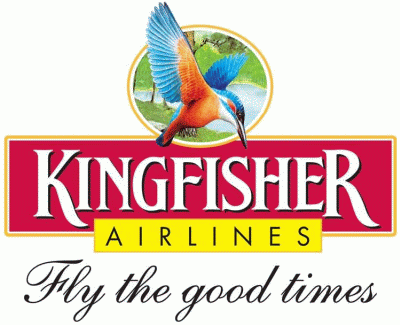 Kingfisher Airlines: An example from closer home. Their acquisition of Air Deccan established them as one of the leaders of the airlines industry in India. Their promise of a “good time” had people queuing up. The Branson’esque flamboyance of the owner helped the airline get more than its fair share of attention. They took a leaf out of PanAm by leading an explicit but unstated promise of stewardesses who were good enough to walk the ramp as models. The airline eventually was grounded as it ran up debts way beyond its ability to pay. The Kingfisher wasn’t flying anymore! It can be argued that the entire fiasco did not have a positive impact on the original brand of beer by the same name and on the holding company.
Kingfisher Airlines: An example from closer home. Their acquisition of Air Deccan established them as one of the leaders of the airlines industry in India. Their promise of a “good time” had people queuing up. The Branson’esque flamboyance of the owner helped the airline get more than its fair share of attention. They took a leaf out of PanAm by leading an explicit but unstated promise of stewardesses who were good enough to walk the ramp as models. The airline eventually was grounded as it ran up debts way beyond its ability to pay. The Kingfisher wasn’t flying anymore! It can be argued that the entire fiasco did not have a positive impact on the original brand of beer by the same name and on the holding company.Coming back, the three brands did have a great product/service that gave them a distinct identity and a position of leadership. However, mismanagement in some form or the other led to the brands fading away but not before they had lit up the sky!
Bounce
Timing Out : When Brands Need to Say Goodbye
 We have often talked about the emotional bond that brands create with consumers and how it is their raison d’etre. The flip side and perhaps also the down side is the emotional bond that brands form with their creators and managers. Several brand managers and businesses have been guilty of stretching brands beyond, well beyond their limit.
We have often talked about the emotional bond that brands create with consumers and how it is their raison d’etre. The flip side and perhaps also the down side is the emotional bond that brands form with their creators and managers. Several brand managers and businesses have been guilty of stretching brands beyond, well beyond their limit.So how does one really know that it’s time? Unfortunately there are no easy answers. However, we do have some lead indicators that emerge from collective wisdom and common sense. Brands are tricky, we all know that. There is no single definition of brand success.
I for one come from the school of thinking that professes and propagates that brands exist for the sole reason of making businesses uniquely identifiable and profitable. Therefore, true brand measures ought to have blended business metrics.
Coming back. What should we as marketers look out for? The best metrics are invariably those that are rooted in market context. After all reality is a key requirement for a reality check!
The best metrics are invariably those that are rooted in market context. After all reality is a key requirement for a reality check!
Brands typically monitor and map their performance on the following dimensions (or similar)• Recall (Memorability)
• Perceived Quality (Premium)
• Revenue Share (Significance)
• Profit Share (Viability)
• Voice Share (Visibility)
• Relevance (Utility)
• Engagement (Sociability)The seed of this post came from a recent news item that announced the winding down of HMT watches. A brand that was anchored in a nations pride and one that definitely made a mark with atleast two generations of independent India.
If one were to put the above parameters together to construct a health radar, HMT watches one would have seen the brand perform poorly on all of these parameters not today but over atleast a 10 year period.
The call to wind down should perhaps been taken long ago instead of allowing the brand to bleed to death. One may argue that it’s the either the fate or fortune of Public Sector companies in India that the get such extended runs. Fortune because the being a Public Sector Undertaking means a long leash and fate because the long leash often means inaction.
HMT watches is not the only example of brands dying slow painful deaths and for sure the phenomenon is not limited to the public sector alone.
Ambassador another memorable brand owned by Hindustan Motors remained active albeit propped up by its “taxi” and “state vehicle” tag. Long after it had faded the brand managers wanted to give it a might heave with a souped-up version christened Amberoid till reality bit them!
There are bound to be ups and downs in every brands life. The revival, rejuvenation plans should kick into place while most of the markers on the Health radar are still in the pink. It is for the businesses to decide basis their “strategy”. The answers can only emerge from the ability to impact the multiple dimensions enlisted above.
As they say, “An honourable exit is saying goodbye while there are more people asking why rather than why not!”3 1/2 Signs of Lazy Marketing
 No less than a dozen brands are vying for the consumer’s attention every waking minute of the day. Some pleading, some enticing and yet others imploring him to give them space and preference.
No less than a dozen brands are vying for the consumer’s attention every waking minute of the day. Some pleading, some enticing and yet others imploring him to give them space and preference.In such a situation, brands and even more importantly those managing these brands need to work extremely hard for their communication to register. Despite being aware of the acute attention deficit some marketers go ahead and release sub-par communication, products and sub-optimal support.
Now one may argue that effective marketing need not necessarily be intelligent but it sure needs to be hard working. It cannot be denied that marketing must eventually end up moving the needle as far as a brand’s awareness, recall, preference, premium, profits, share etc. are concerned.
Often though marketing managers fall into the trap of creating a go to market plan simply because there must exist one. Succumbing to the pressures of fighting the competition, maintaining the share of voice, launching with full aplomb, keeping the channel partners satisfied do tick box but this approach is what breeds “Lazy Marketing”.
So here are 3 ½ signs of Lazy Marketing to watch out for. They might not exactly be as fundamental as the 4P’s but they are a good set of lead indicators if you are in the planning phase.
 Bigger, better, faster, more
Bigger, better, faster, moreIf a product is just about being bigger, better, faster, more as compared what competition has to offer then you know that there is little differentiation involved. So if you hear better mileage, smoother ride or larger, brighter display you know!
 Pricing Paralysis
Pricing ParalysisMost marketers seem to have forgotten about using pricing as lever. If ever they do it’s a defensive move which more often than not says “Hey I am not really sure if my product is better than the other guy, but I am lower priced”. When they do price higher they go on a justification trip. Pricing should signal value and if it doesn’t someone is being lazy.
 Feeding the Fad
Feeding the FadLet’s face it there are only so many ways of doing things and innovation is a stranger who comes into town very rarely. But the worst thing all of us as marketers can do is feeding the fad. Can’t come up with a good activation “Let’s do a flash mob”. Want to get some consumer interaction going “Let’s get people to post selfies!” Ideas do not need to be novel nor do they need to be in vogue, they need to relevant.
And now for the ½ sign
 Leave it to the celeb
Leave it to the celebMarketers must work hard if they want to get this piece right. Yes the decisions get made based on the wisdom at their disposal but never ever should a product or brand allow itself to be carried by a celeb. History is replete with examples that shout out “If the product isn’t great or the story is weak the celeb cannot do it for you.”
Avatars: How Mascots Help Brands Engage Better
 We have all as marketers discussed, debated, worked on creating, shaping, modifying the brands that we have managed. Often the central point of conversation would have been about the brand character, its personality. We would either have brand bibles that gave a pen picture of the brand or at times written one de novo.
We have all as marketers discussed, debated, worked on creating, shaping, modifying the brands that we have managed. Often the central point of conversation would have been about the brand character, its personality. We would either have brand bibles that gave a pen picture of the brand or at times written one de novo.What these pen pictures do is that they make the brand tangible for us. As marketers we have given several dimensions such as names, personalities, characteristics some have also given their brands a face!
Mascots for brands have been around for as long as we have known brands. Brands with mascots achieve a lot with very little. It takes most brands time and effort in the form of consistent communication to establish the character traits and a personality for themselves. Of course along with a Hail Mary for it to be understood by the consumers the way it is intended.
Today more than ever before, in an era of increasing choices and decreasing attention spans mascots can play a very significant role in carving consumer mind-space for brands. The digital natives of today understand and also identify with the concept of “avatars”. The digital natives understand that though not the actual person, the avatars are perhaps the nearest likelihood or the self-projection.
From a brands perspective it allows consumers to interact with a “face” or a “person” instead of some nameless, faceless representative. It adds that little bit of familiarity which is key for brand comfort.
Mascots help the brand engage better with its consumers
- They can be de facto brand spokespersons. Mascots can have real time presence in sociosphere, sharing, commenting, reacting and interacting with consumers all across.
- Mascots are more flexible than other brand assets and identifiers such as logos, colors and fonts. They can speak different languages, dress for the occasion helping brands localize and customize messages. Take on multiple avatars!
- The mascot can be a brands promoter at the point of sale. Driving recall, reinforcing the brands core values and even delivering a sales pitch.
- Brand ambassadors may switch or cease to be relevant but mascots will always belong to the brand.
- The sheen of the brand may diminish over time but mascots are ageless. Sometimes even out surviving the brand.
Mascots needn’t necessarily be cartoons, caricatures or animated characters alone. They can be and are human too. Many brands have successfully created characters and used them in communication across multiple touch points.
Here are a few brands and their mascots that according to me have served or are serving their brands superlatively across TV commercials, radio spots, print ads, hoardings and web films.
Look forward to your thoughts.
E.Q. -Brands that tugged at your heart
“I’ve learned that people will forget what you said, people will forget what you did, but people will never forget how you made them feel.”
Maya Angelou
This quote has been and continues to be a guiding factor for me as a marketing professional. It can be universally applied to not just to interpersonal situations but to communication as well. If the intent of all brand communication is to create positive impressions that at some point result in a purchase decision in favour of our brands and products then, how it makes one feel on reception is of paramount importance.
 If one were to look at brand messaging and how consumers would “warm up” to the brand there are 4 distinct levels. Communication that talks about the product and its features alone would get the coldest response. The prospects improve to lukewarm once you move from the I to the you and I space where there is talk of benefits. The slightly warmer zones are where brands cater to the status and social needs. The hottest zone is where the brand creates a connect with the consumer at an emotional level.
If one were to look at brand messaging and how consumers would “warm up” to the brand there are 4 distinct levels. Communication that talks about the product and its features alone would get the coldest response. The prospects improve to lukewarm once you move from the I to the you and I space where there is talk of benefits. The slightly warmer zones are where brands cater to the status and social needs. The hottest zone is where the brand creates a connect with the consumer at an emotional level.There are dozens of research papers that define and describe the range of human emotions putting them into positive and negative buckets. Marketers have for long argued whether to go the factual, cut and dry rational way when they communicate or to appeal to & arouse the consumer’s emotions to get them across the line.
 Derrick Daye at the Blake Project in his article 5 Drivers of Brand Insistence says that the ultimate goal of brand equity building is to move the consumer from brand awareness to brand insistence. He opines that there are five elements that drive a consumer to insist upon a particular brand to meet his or her needs – brand awareness, accessibility, value, relevant differentiation, and emotional connection.
Derrick Daye at the Blake Project in his article 5 Drivers of Brand Insistence says that the ultimate goal of brand equity building is to move the consumer from brand awareness to brand insistence. He opines that there are five elements that drive a consumer to insist upon a particular brand to meet his or her needs – brand awareness, accessibility, value, relevant differentiation, and emotional connection.That being said a brand cannot just churn out arbitrary sentimental stuff that has no connect with what they do or offer.
One question that needs to be answered is whether the communication conforms to or breaks the pattern. In a category where emotions are the norm another communication would not break clutter. Also, does the communication provide adequate proof points to the consumer? Remember it’s not enough to get the consumer all mushy, eventually all communication needs to translate into strengthening the brand.
Here’s a compendium of TVCs that caught my eye. They straddle a host of emotions and categories. Interesting to note how many of these brands are leaders in their categories. Some of them go beyond emotion and deliver a strong brand message whilst others definitely touch your heart yet fail to do much else.
[youtube=http://www.youtube.com/watch?v=HkuKHwetV6Q&list=PLdEKkPjjrZSfQD04FfQWvBnzMTb7DjfzM]
To leave your thoughts use the voting buttons J
[polldaddy poll=8210912]

